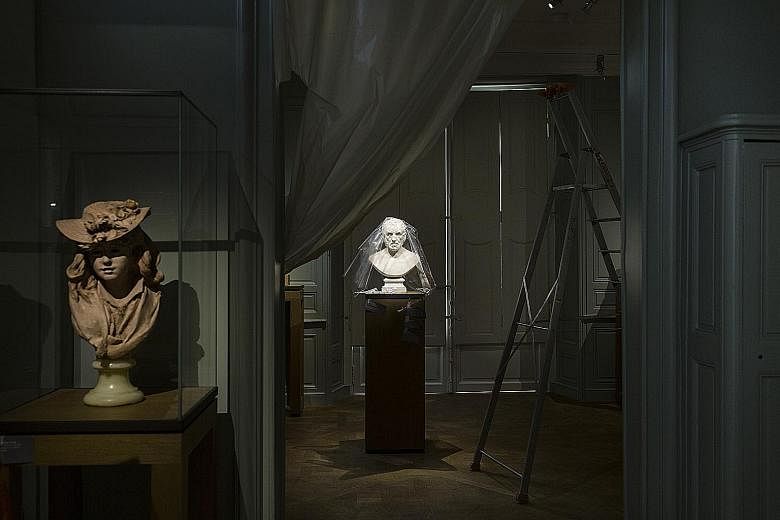PARIS • At the end of his life, sculptor Auguste Rodin ceded his valuable art collection and plaster moulds to the French state, part of a deal he negotiated to save the palatial, 18th-century mansion that housed his studio and create his own museum on the Left Bank.
Now, he and his vintage moulds have again come to the museum's rescue. The sales of newly cast Rodin bronzes are helping to finance a US$17.7-million (S$25- million) restoration of the Rodin Museum, where cracks in the walls have appeared over the decades and where the oak parquet floors have warped with the weight of sculptures, including the marble lovers entwined in The Kiss.
It is the first major renovation for the two-storey Hotel Biron, which stands within a formal garden in view of the golden dome of Les Invalides. The museum has been closed since January as part of a three-year construction project that is nearing completion, with a public reopening scheduled for Rodin's birthday on Nov 12.
The aim of the restoration, according to the museum's architects, is to evoke the creative atmosphere that inspired the sculptor, who retreated here because, he said, "my eyes encounter grace, sitting here surrounded by light".
The makeover features more natural light, new colours and the reappearance of Rodin's personal art collection, which also includes ancient Greek sculpture fragments. Many of the marble sculptures, including The Kiss, have been cleaned for the first time and restored to their original lustre.
"We want visitors to be immersed in sculptures," said Ms Catherine Chevillot, the museum's director, who took charge of the construction when she started in 2012.
The museum has other grand plans: an US$11-million restoration of the gardens surrounding the mansion and an US$8.8-million renovation at the site of Rodin's former home in Meudon, outside Paris.
But those ambitions may be constrained by the museum's unusual income, which will eventually reach its limits. The museum holds the rights to any works cast from its moulds, allowing it to sell the pieces to raise money. Because of that revenue, the Rodin mansion is the only national museum in France that finances its operating budget (US$14.34 million this year) without government subsidies. More than half of the budget is generated by sales of limited-edition bronzes made from the moulds and the rest by ticket and store sales and other usual forms of museum revenue.
While the museum has zealously guarded its right to the casts with lawsuits in France and other countries for copyright violations, that revenue stream is limited.
French regulations cap the number of sculptures created from original moulds at 12. So the museum is running out of opportunities to cast almost all of Rodin's major works although it can still cast from hundreds of moulds for other smaller works.
The lucky recovery of part of the mould for a theatre decoration, one of Rodin's last works, has helped extend the potential for castings.
After the museum found the mould for the upraised hands of the figure, Aphrodite, a work was cast last year for the first time. The museum sold that bronze for more than US$1.1 million this summer at Christie's in London to a Chinese collector.
"They don't have many more big pieces because most editions are sold out," said Mr Gilles Perrault, an art expert for France's high court, the Cour de Cassation, who has tracked fake reproductions of Rodin. "They may have a few more examples left. But today, what the Rodin museum makes are mostly little pieces and variations."
At first glance, the Hotel Biron looks largely unchanged from the renovation. Yet within its interior, with exhibition space for 600 works spread across 18 rooms, it has undergone a structural makeover to recreate the period when Rodin worked in a south-facing, ground-floor studio.
Built in 1732, the mansion housed a wealthy wig maker and financial speculator, then waves of aristocrats until 1820 when it was turned into a Catholic boarding school before the French state took possession. After it was put up for sale in 1905, the building was ultimately rented out to artists and became a refuge for tenants such as Rodin; his lover, Camille Claudel; French artist Henri Matisse; and dancer Isadora Duncan, among others.
Rodin began renting studio space there in 1908 and worked there until the end of his life. Before he died in 1917, he negotiated the agreement with the French state, which still owned the building, to turn it into a museum. It now attracts 700,000 visitors annually, 80 per cent of them foreign tourists.
Rodin's gift is still keeping his wishes alive.
At the end of the year, the museum is to deliver a new casting of his monumental bronze of The Gates Of Hell to Mexican billionaire Carlos Slim for display at the Soumaya Museum in Mexico City, Ms Chevillot said.
Museum officials point out that The Thinker, The Burghers Of Calais and Monument To Balzac have been cast the maximum allowable number of times, but, they said, four more editions of The Gates Of Hell and two of The Kiss remain available.
NEW YORK TIMES

